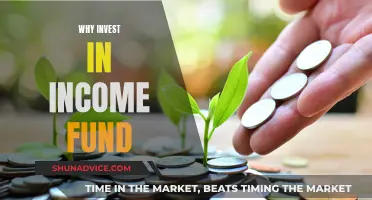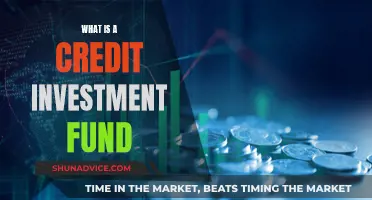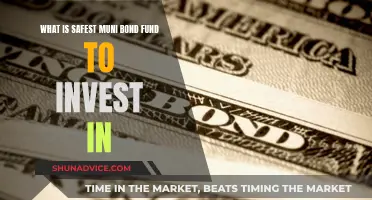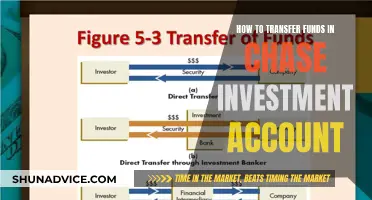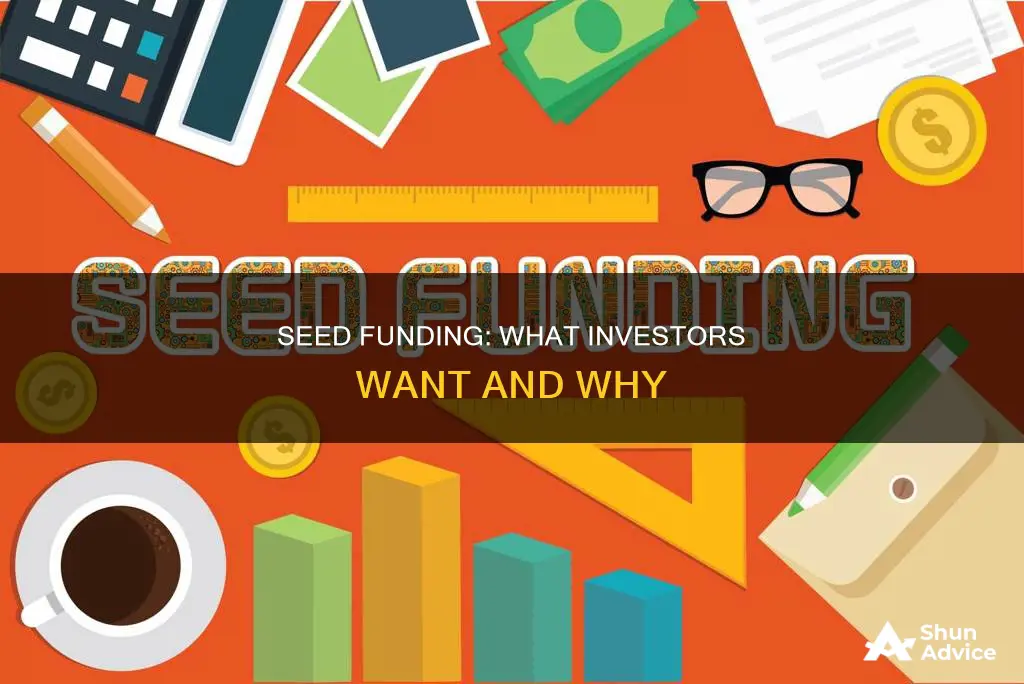
Seed funding is the earliest stage of funding for a startup, provided by angel investors, friends and family, and early-stage venture capital firms. It is the first infusion of capital that a startup receives to develop its idea, conduct market research, and build a prototype. Seed funding is typically smaller than Series A funding and ranges from €50,000 to €2 million. It is considered a high-risk investment, as startups are in the early stages of development, and there is no guarantee of success. However, seed funding can offer investors the opportunity to get in on the ground floor of a potentially successful business.
| Characteristics | Values |
|---|---|
| Type of funding | Initial capital to jumpstart a business idea |
| Sources of funding | Friends and family, angel investors, venture capital firms, incubators, accelerators, debt funding, convertible securities, personal capital |
| Amount of funding | €50,000 to €2 million |
| Funding recipients | Startups with a strong founding team, a scalable and innovative business idea, early traction, and a large addressable market |
| Funding recipients' goals | Develop a product or service, build a team, establish a market presence, conduct market research, build a prototype |
| Exchange for funding | Equity in the company, preferred stock, future equity, convertible debt |
| Percentage of equity given up | 10% to 25% |
| Funding risk | High-risk investment |
What You'll Learn

Sources of seed funding
Friends and Family
The most common method of seed funding comes from friends and family. Many startup founders have friends or family members who also own businesses or are able to invest. This route is often quicker and more flexible than other sources, but it does carry the risk of damaged relationships if things go wrong.
Angel Investors
Angel investors are wealthy individuals who invest in early-stage startups using their own money. They are often experienced entrepreneurs who can advise a new business and help them to make the right moves. They may invest through a loan or in return for equity in the company. Angel investors can be found through angel-finding websites or specialist angel investor networks.
Venture Capitalists
Venture capitalists (VCs) are firms built specifically to provide funding to companies. They are the most conventional route of funding, especially as startups move into Series A funding and beyond. Many VCs are open to seed funding, but they can be incredibly scrupulous, requiring several meetings and involving many stakeholders.
Accelerators and Incubators
Accelerators and incubators are enterprises built to assist founders through the process of launching and growing a company. They can provide seed funding, mentorship, and networking platforms to connect with investors, mentors, and other startups. In return, they usually take equity stakes in the company.
Crowdfunding
Crowdfunding has become a popular alternative, with sites like Kickstarter helping thousands of founders launch their startups. This form of seed funding involves creating a campaign built on product pre-sales and then convincing hundreds or thousands of donors to invest in the product before it’s put to market.
Government Grants and Funds
Some governments offer grants and funds to support entrepreneurs and startups. These can include rebates, tax exemptions, and loans disbursed via government-backed banks or funds.
Congress Funding: Kennedy's Convincing Legacy
You may want to see also

Seed funding vs angel investing
Seed funding and angel investing are two of the first few funding rounds a company goes through in its early stages. While both are crucial for a startup's development, there are some key differences between the two.
Seed Funding
Seed funding is the first official equity funding stage for a startup, marking the first official money a business venture raises. It is used to cover the costs of creating a proposal, including business plans, initial operating expenses, rent, equipment, payroll, insurance, and research and development costs. Seed funding is generally used to employ a founding team to determine the final products and target demographic.
Seed funding is often obtained from venture capital firms, incubators, and early-stage investors. These investors are typically more risk-tolerant and willing to invest in unproven ideas and concepts. The amount of funding usually ranges from tens of thousands to a few hundred thousand dollars.
Angel Investing
Angel investing is another early-stage funding round, typically following seed funding. Angel investors are individuals who invest their own money into early-stage businesses in exchange for equity. They can be anyone with a large sum of money and an interest in investing in a company, and they often have a personal connection with the startup, such as friends and family. Angel investors are generally high-net-worth individuals who may come from the personal network of a startup's founder(s).
Angel investing occurs when a startup has made progress by building a minimum viable product (MVP), acquiring early customers, and generating initial revenue. The funding is used to help startups scale their operations, refine their products, and gain market traction. Angel investments typically range from a few hundred thousand dollars to a few million dollars.
Angel investors are more actively involved in the startup's operations than seed investors, bringing industry expertise, networks, and actively participating in strategic decision-making. They may also provide guidance and mentorship to the startup.
A Beginner's Guide to Mutual Fund Investment
You may want to see also

Seed funding vs venture capital
Seed funding is the first official equity funding stage for a business venture or enterprise. It is the first of four funding stages required for a startup to become an established business. It is generally used to develop a business idea to the point that it can be presented to venture capital firms.
Seed funding covers the costs of creating a proposal, including a business plan and initial operating expenses such as rent, equipment, payroll, insurance, and research and development costs. It is often sourced from family, friends, and other acquaintances.
Venture capital, on the other hand, is the second round of funding that a company receives from investors. It is typically larger in size and is used to finance the growth of a company, including expanding into new markets, developing new products or services, and hiring new employees. Venture capital firms tend to invest in businesses that have proven their revenue model or have a sizable and rapidly growing customer base.
Venture capital firms invest in common equity, preferred shares, and convertible debt securities in companies. They focus on equity upside, aiming to eventually own equity. They also tend to take a more passive role in a company's development.
In summary, seed funding is the initial funding stage for startups, helping them get off the ground, while venture capital is a larger, more established round of funding that helps companies expand and grow.
Key Factors for Investors to Consider in Mutual Funds
You may want to see also

How to raise seed funding
Raising seed funding is a crucial step for any startup, as it provides the financial fuel needed to transform an idea into a successful business. Here are some detailed and direct instructions on how to raise seed funding:
Understand Seed Funding
Seed funding is typically the first official round of funding for a startup, coming after any pre-seed funding from the founders, friends, or family. It is designed to help cover the initial costs of developing a business idea, such as market research, product development, and operational expenses. In exchange for their investment, seed funders usually receive equity in the company or a share of the profits.
Identify Potential Sources of Seed Funding
Seed funding can come from various sources, including friends and family, angel investors, incubators, accelerators, and venture capital firms. Friends and family are often the most common source, as they are more likely to invest in an idea at an early stage. Angel investors are high-net-worth individuals who invest their own money in startups, often playing a hands-on role in the company's development. Incubators and accelerators provide mentorship, resources, and funding to help startups grow. Venture capital firms, on the other hand, thrive on high-risk, high-reward funding and mainly focus on funding startups.
Prepare a Compelling Pitch
Before approaching potential investors, it is essential to have a well-rounded business plan that showcases the startup's potential. This includes conducting thorough market research, identifying target customers, performing a SWOT analysis, and developing financial projections and growth estimates. A strong pitch will also include information on the competitors, current and potential valuations, and the unique value proposition of the startup.
Network and Build Connections
Attending startup events, networking through websites and forums, and leveraging social media can be excellent ways to connect with potential investors and other founders. Building a solid network can increase the chances of securing seed funding, as it provides visibility and access to a wider pool of investors.
Explore Digital Platforms and Websites
Many websites and services are dedicated to helping startups secure funding. Angel-finding websites, such as Angel Investment Network, directly connect founders with angel investors globally. Crowdfunding platforms like Kickstarter and GoFundMe allow startups to raise funds in exchange for equity. Additionally, loan options, such as SBA loans, are available for small businesses seeking quick capital.
Consider Incubators and Accelerators
Incubators and accelerators can be excellent options, especially for high-growth startups seeking more than just funding. These programs provide mentorship, resources, networking opportunities, and funding to help startups succeed. However, it is important to note that joining an incubator or accelerator usually involves giving away a percentage of ownership in the company.
By following these steps and creating a solid foundation for their startup, entrepreneurs can significantly increase their chances of securing the seed funding needed to turn their vision into a thriving business.
Skills for Investment Fund Managers: Expertise for Success
You may want to see also

What seed investors look for
Seed funding is the first official equity funding stage for a startup. It is the first of four funding stages required for a startup to become an established business. Seed investors are typically individual angel investors, formal angel organisations, or venture capital funds.
A Solid Return
Angel investors are looking for a higher return on their money than they would receive on the stock market, but this comes with a high degree of risk. They are looking for a return of seven dollars for every dollar they invest in seven years.
A Good Reason to Invest
Angel investors can be categorised into three groups: economic, hedonistic, and altruistic. Hedonistic angel investors are attracted by the excitement of creating something new, while altruistic angels may be more concerned with helping their community. Economic or entrepreneurial angels tend to invest in a greater number of companies, take more active roles, and earn better returns.
A Solid Management Team
Angel investors want to see evidence of observant, competent, and trustworthy leaders. A well-rounded management team will include leaders with experience in human resources, manufacturing, accounting, sales, and research.
A Solid Business Plan
Investors want to see a convincing and complete business plan, including financial projections, detailed marketing plans, and specifics about a target market. They want to see a developed vision that includes details of how to grow the business and remain competitive.
A Business Structured for Investment
Angel investors are looking for a minority equity ownership position, so a business must be structured to allow for equity investment. Owners must be prepared to give up a certain amount of control in exchange for money and will usually be expected to sign a formal shareholder agreement.
The Opportunity to Be Actively Involved
Many angel investors expect to actively contribute their time by acting as a mentor, serving on the board of directors, or taking an active role as a manager.
A Viable Exit Strategy
Angel investors will expect to be presented with a variety of exit strategies and a comprehensive risk analysis for each. The sale of shares to a company's principals is a common exit strategy for angel investors who hold equity ownership positions, while the sale or merger of a company is common for debt-holding investors.
A Problem to Solve
Seed investors will want to know what problem the company is trying to solve and how big that problem is. They will also want to know if the problem is real and validated by customers, and if the solution is a "must-have" rather than a "nice to have".
A Solution
Investors will want to know if the founders are well-placed or uniquely qualified to come up with a solution. They will also want to know if there is evidence that customers like the solution, if it is better/faster/cheaper than other solutions, and if it can scale globally.
A Large Market
Seed investors will want to know if the target market is big enough to enable the company to grow to a multibillion size. They will also want to understand the market dynamics and why now is the right time for the market to change or for new entrants to emerge.
A Strong Business Model
Investors will want to know if the projections and assumptions in the business model are realistic and if they can be tested. They will also want to know if there are network effects built into the business model, i.e. does the product get better the more users there are?
Funding Requirements
Seed investors will want to know if the investment fits their fund strategy and if they can provide the capital the company needs. They will also want to know the right entry price or valuation and the subsequent funding requirements.
Value Creation
Investors will want to know if the company has a patent portfolio, a piece of defensible technology, a unique dataset, or a team with unparalleled expertise. They will also want to know if the company has built a community of early customers or advocates and how much value can be captured from the solution.
Competition & Defensibility
Seed investors will want to know how crowded the market is and if there are moats the company can build or high barriers to entry. They will also want to know if there is a significant "incumbent advantage" or if an existing giant is moving into the space.
Exit Strategy
Investors will want to know who will ultimately buy this company and why and when a company would buy it. They will also want to know on what metric it would be valued and if there are any proxies for the kind of price that would be paid.
Risk
Seed investors will want to know what the key risks are and if they are taking enough risk. They will also want to know if the company is a "moonshot", i.e. if it succeeded, could it generate "outsized returns".
A Strong Team
Investors will want to know if the team has a unique advantage or edge and if they have raw intelligence. They will also want to know if the team acts with integrity, is mission-driven, and has a noble purpose. They will want to know if the team can lead and hire fantastic people, if they are commercial and can sell, and if they understand the market and the product they are selling. Finally, they will want to know if the team has grit, ambition, and hustle, if their skills gel well as a group, and if they are humble and will listen.
Best Banks for Mutual Fund Investments in Pakistan
You may want to see also
Frequently asked questions
Seed funding is the earliest stage of funding for a startup, provided by angel investors, friends and family, and early-stage venture capital firms. It is the first infusion of capital that a startup receives to develop its idea, conduct market research, and build a prototype.
Seed funding usually ranges from €50,000 to €2 million, but can be in the millions of dollars.
Investors typically receive equity in the company, becoming shareholders with a stake in the success of the business. The amount of equity given up by the startup in exchange for funding is generally between 10% and 25%.


